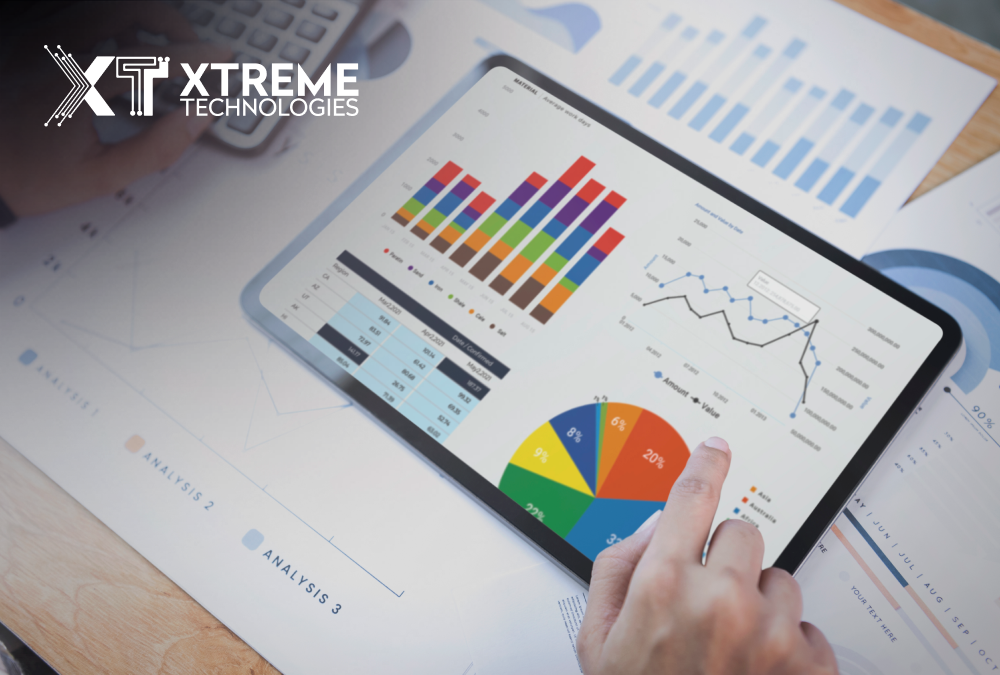
Unlocking the Power of Social Media Analytics: A Comprehensive Guide for Your Marketing Agency
All, Business, Marketing, Social Media,
Published on: October 31, 2023
Social media has become a tool for advertising agencies in today’s evolving digital landscape. However simply having a presence on these platforms is no longer sufficient. Marketers must navigate the complexities of social media analytics to leverage the potential of these channels. This comprehensive and informative guide will take you on a captivating journey into the realm of social media marketing services using analytics. Within this article we delve into the core concepts, strategies and resources that shape this field. It's a journey that unveils the power of data equipping advertising agencies with the knowledge to execute campaigns precisely target specific audiences and achieve enduring results, beyond digital boundaries. Consider this guide as your compass leading you and your agency towards an era where social media transcends mere trendiness and becomes a potent strategic force. It's a realm where facts and figures reign supreme and where your organization can conquer any objective it sets its sights on.
Chapter 1 - Understanding Social Media Analytics
Gone are the days of solely relying on traditional advertising methods. Instead, marketing agencies are increasingly turning to social media to reach and engage with their target audiences. However, simply being present on social media is not enough; understanding the intricacies of social media analytics is crucial for success.
What is Social Media Analytics?
Social media analytics is a discipline that serves as the foundation for digital marketing strategies. Essentially it involves a data driven approach to comprehending the dynamics of social media. This comprehensive process encompasses gathering, analyzing and interpreting data from social media platforms. It's like taking on the role of a detective sifting through a vast sea of metrics and data points generated by social media interactions. By looking at things through this lens one can gain insights into their target audience's behavior—a valuable compass that directs marketing efforts. One disadvantage of segmentation in social media marketing analytics is the potential oversimplification of complex consumer behaviors. One aspect of this process involves examining the footsteps of the audience, uncovering patterns, preferences and habits. This helps to shed light on the underlying reasons behind user actions revealing what motivates engagement, sharing and interaction. Additionally social media analytics delves into content performance—each post, video or image becomes a data point on a canvas of insights. Metrics such as engagement rates, click through rates. Reach serves as indicators along the path to assessing content effectiveness. However social media analytics goes beyond understanding; it becomes a springboard for decision-making. Equipped with these insights, marketing professionals have the knowledge to make informed decisions supported by data. These decisions serve as the guiding principles that lead to optimizing campaigns, refining content and allocating resources effectively.Why is it Important for Marketing Agencies?
At its core social media analytics holds potential for transformation. It takes data and then transforms it into practical intelligence converting numbers and statistics into strategic wisdom. It acts as an element in marketing strategies empowering professionals to navigate the ever-changing landscape of social media with accuracy and purpose. Through this perspective the digital realm becomes a world of opportunities where data driven approaches pave the way for increased engagement, brand resonance and ultimately achieve marketing success. Social media analytics is paramount for marketing agencies for several compelling reasons:-
Data-Driven Decision Making:
It provides a data-driven marketing approach. Agencies can base their strategies on real insights rather than gut feelings or assumptions. -
Audience Understanding:
Social media analytics helps agencies understand their target audience better. They can identify demographics, interests, and behaviors, allowing for more precise targeting. -
Content Optimization:
By tracking metrics such as engagement, reach, and click-through rates, agencies can refine their content strategies for maximum impact. -
Competitive Advantage:
Agencies that harness the power of social media analytics can gain a competitive edge. They can adapt quickly to changing trends and market dynamics.
Important Metrics that you should Monitor
In the realm of social media analytics there are metrics that offer insights. Here are some crucial metrics that marketing agencies should keep track of;-
Engagement Rate
This metric evaluates how actively your audience engages with your content. It includes actions like likes, comments, shares and clicks. A higher engagement rate suggests content. -
Reach
Reach measures the number of users who have seen your content. It is essential for assessing the visibility of your brand or campaign. -
Click Through Rate (CTR)
CTR calculates the percentage of people who click on a link within your content, such as a call-to-action button. It plays a role in measuring the effectiveness of your CTAs. -
Conversion Rate
This metric tracks the percentage of users who take desired actions, such as making purchases or signing up for newsletters. It directly correlates to the success of your marketing campaigns. -
Growth in Followers
Monitoring the growth in your follower count over time helps assess the expansion of your social media presence. -
Sentiment Analysis
Analyzing sentiment (positive, negative or neutral) in comments and mentions can provide insights into how your audience perceives your brand.
Chapter 2 - Establishing Your Analytics Framework
To fully leverage the power of social media analytics marketing agencies, need to create a framework. This chapter delves into the components of this framework.
Selecting the Right Social Media Platforms
Not all social media platforms are the same as each one has its audience and advantages. Your agency should choose platforms that align with your clients target audience and objectives. Take into account factors, like demographics, content types and engagement levels on platforms such as Facebook, Instagram, Twitter, LinkedIn and TikTok.Choosing Suitable Tools and Software
Social media analytics relies on tools and software. There are options ranging from free social media marketing analytics tools like native platform analytics to more advanced third-party solutions. The choice depends on your agency's budget, specific requirements and desired features. Some popular tools include Hootsuite, Buffer, Sprout Social and Google Analytics for website tracking.Defining Clear Goals and KPIs
Before diving into social media analytics, it is crucial to establish goals and key performance indicators (KPIs). What do you aim to accomplish for your clients? Is it enhancing brand awareness or generating leads? Define KPIs that align with these goals. Examples can include achieving a percentage increase in website traffic or gaining a number of social media followers within a given timeframe.Chapter 3 - Gathering and Analyzing Data
Once you have established your analytics framework the next step involves collecting and analyzing data. This chapter explores the processes involved in detail.
Efficient Data Collection
Efficiently collecting data is essential for making decisions in social media analytics. Marketing analytics using social media platforms requires robust data analysis tools. Data analytics in social media marketing is crucial for understanding customer behavior. It entails setting up tracking mechanisms to capture all information. For instance, implementing conversion tracking on your website allows you to understand how users interact with your site and the actions they take. In addition, utilizing UTM parameters for campaign links provides insights into the traffic sources enabling attribution of conversions to marketing efforts. Furthermore, event tracking enables you to monitor user actions on your website providing data on user behavior. Equally important is closely monitoring social media ad campaigns by monitoring metrics such as click-through rates, engagement levels and conversion rates. This diligent approach ensures that no data goes unnoticed and paves the way for decision-making in your social media strategies.Understanding Engagement and Reach
When it comes to media analytics, engagement and reach play a role. Analyzing engagement means digging into the likes, comments, shares and click through rates that your posts receive. It's like solving a mystery to understand how well your content connects with people and prompts responses. On the other hand, reach measures the extent of your content's influence by quantifying the number of users who have encountered your message. This comprehensive analysis does not measure the impact of your content. Also reveals insights into its quality and relevance. Knowing which content resonates with your audience and how far your message spreads allow you to refine your content strategy for resonance and effectiveness ensuring interactions with your followers.Exploring Audience Insights
Uncovering audience insights is crucial in social media analytics. In this field social media analytics tools act as aids in segmenting your audience. By categorizing them based on demographics, interests and behaviors you gain the ability to identify trends and patterns within each segment. These insights serve as a foundation for tailoring campaigns that deeply resonate with groups. The key lies in personalization. Crafting messages and visuals that directly address the needs and aspirations of each segment. This level of attention to detail does not increase engagement. Also helps establish a strong connection with your audience. It ensures that your campaigns resonate and inspire action. Ultimately understanding your audience becomes the driving force behind developing content strategies that lead to success.Chapter 4 - Utilizing Insights for Crafting Content Strategies
In this chapter we will delve into the use of social media analytics insights to shape your content strategy.
Creating Content Based on Data Analysis
Data driven content lies at the heart of social media marketing. By analyzing metrics such as engagement, reach and conversion rates you can identify which types of content resonate most with your audience. Utilize these insights to develop content that addresses the pain points, interests and preferences of your audience. Additionally, consider incorporating trending topics or relevant hashtags to increase visibility.Tailoring Content for Specific Target Audiences
One size does not fit all in social media marketing. Use audience segmentation based on demographics, behaviors and interests to customize content for groups. Craft. Visuals that directly speak to the needs of each segment. This personalized approach enhances. Fosters a deeper connection with your audience.Optimizing Posting Schedules
The timing of your social media posts can significantly impact their effectiveness. Social media analysis can provide insights into the responsive periods of your audience. Utilize this information to schedule your posts during peak engagement times. Experiment with posting schedules to discover the optimal timing for your specific target audience on each platform.Chapter 5 - Assessing Campaign Performance
Once you have implemented your content strategy, monitoring and optimizing your campaigns for impact becomes vital.
Monitoring the Success of Advertising Campaigns
For paid social media campaigns continuous monitoring is essential. Keep track of metrics such as click through rates, ad impressions and conversion rates. Analyze which ad creatives and copy perform the best. Allocate your budget accordingly. Make real time adjustments to optimize ad campaigns for outcomes.A/B Testing and Optimization
A/B testing involves running two versions of an ad or content piece to determine which one performs better. Employ social media analytics to conduct A/B tests on ad creatives, headlines or landing pages. Regularly evaluate the results. Refine your strategies based on what resonates effectively with your audience.Measuring Return on Investment (ROI)
Return on investment (ROI) serves as the metric for evaluating the success of your social media marketing endeavors. Calculate ROI by comparing the revenue generated against the costs incurred for each social media marketing campaign. Social media analytics can be a tool in monitoring conversions. Attributing them to particular social media actions, which enables you to accurately measure return on investment (ROI).Chapter 6: Staying Ahead in a Changing Digital Landscape
In today’s digitally paced world it is crucial to stay competitive. This chapter focuses on strategies for maintaining your edge through the use of social media analytics.
Keeping an Eye on Your Competitors Actions
One strategy in the landscape is to monitor your competitors' activities on social media. By using social media analytics tools your marketing agency can gain insights into your competitors’ online presence. This allows you to track engagement metrics, analyze content strategies and understand audience demographics. By analyzing what works well for your competitors you can gain insights that inform your own social media marketing efforts. Understanding which posts generate the engagement, identifying recurring content themes and finding posting schedules are key factors in staying competitive. Furthermore, by observing their use of hashtags, keywords and campaign strategies you can. Align your approach with the evolving dynamics of your industry. Essentially competitor analysis through media analytics becomes a learning process that empowers your agency to adapt, innovate and thrive in the ever-changing world of social media marketing.Adapting Strategies Based on Industry Trends
In the field of social media marketing adaptability is vital, for long term success. The market size of social media analytics has significantly increased in recent years. The social media world is always changing, with trends and audience behaviors evolving. It's not just helpful. Essentially, for marketing agencies to keep up with these industry trends. In this context social media analytics becomes a tool that guides agencies through the digital landscape. By using analytics tools agencies can accurately identify emerging trends in the industry. This involves monitoring social media platforms tracking metrics that show the growing popularity of hashtags recognizing captivating content formats that are gaining traction and staying tuned in to trending topics that resonate with their target audience. With this knowledge agencies can adapt their strategies seamlessly. Ensure they remain relevant and appealing to their audience. Taking this approach not only grabs the audience's attention but also demonstrates the agency's ability to anticipate and embrace the ever-changing dynamics of digital marketing. Marketing analytics for social media helps businesses refine their online strategies for better results. This solidifies their position as leaders, in the shifting realm of social media marketing.Continuous Learning and Progress
Social media analysis is not a one-time task but a continuous effort. Foster a culture of learning within your organization. Regularly assess performance data, identify areas for improvement and explore strategies. Encourage team members to participate in webinars, workshops and conferences to stay updated on the advancements in social media marketing.Chapter 7 - Tools and Resources
The best way to track analytics in social media marketing is through comprehensive tracking tools and platforms. There is a growing market for social media analytics tools as businesses recognize their importance in decision-making. This chapter provides an overview of tools and resources for social media analysis. Overview of Tools for Social Media Analysis
Overview of Tools for Social Media Analysis
-
1. Google Analytics
Google Analytics is a widely used tool for web analytics. While its primary focus is tracking website performance it also plays a role in social media analysis. Google Analytics for social media marketing provides valuable insights into the effectiveness of your social media campaigns, helping you make data-driven decisions for improved online visibility.-
-
Tracking Website Performance:
Google Analytics offers insights into website traffic, user behavior and conversion rates. You can monitor the number of visitors coming from social media platforms, their interactions, on your site and the pages they visit. -
Social Media Referrals:
Google Analytics enables you to identify which social media platforms are driving the traffic to your website. You have the ability to analyze how effective your social media campaigns are and determine which platforms yield the results. -
Tracking Conversions:
This feature allows you to set goals and monitor conversions that originate from media, such as form submissions, e-commerce transactions or downloads.
-
-
-
2. Hootsuite
Hootsuite is a used platform for managing media that offers both scheduling and basic analytics features;-
Scheduling Social Media Posts:
With Hootsuite you can schedule posts across various social media platforms. This functionality ensures that your content is published at times streamlining its distribution. -
Basic Analytics:
Hootsuite provides analytics on post-performance. You can track metrics like engagement, clicks and impressions to evaluate the effectiveness of your content. -
Monitoring and Engagement:
Additionally, Hootsuite includes tools for monitoring conversations happening on social media platforms in order to respond to comments and messages easily. This feature makes it simpler for you to engage with your audience.
-
-
3. Buffer
Buffer is a social media management platform that offers scheduling and basic analytics features. With Buffer you can easily schedule posts, for social media platforms ensuring a posting schedule. It also provides insights into post performance allowing you to track metrics like likes, comments and shares to gauge the impact of your content. Buffer is particularly user friendly and suitable for marketing agencies or teams. -
4. Sprout Social
Sprout Social on the hand is a social media management and analytics tool renowned for its advanced capabilities. It offers in depth social media analytics that include reports on engagement, audience demographics and post-performance. This valuable information helps you understand what resonates with your audience over time. Additionally Sprout Social allows you to monitor conversations and mentions related to your brand or industry through its listening feature. This provides insights into brand sentiment and emerging trends. Furthermore, this tool facilitates collaboration within marketing teams by providing reports that can be shared with clients. These tools are designed to manage your social media presence by offering scheduling options and robust analytics capabilities. Sprout Social is a choice for agencies seeking social media analytics capabilities and a comprehensive management platform. -
5. Google Data Studio
Google Data Studio is a tool for visualizing data that can help you create customized dashboards and reports to better understand your social media data;-
Custom Dashboards:
With Google Data Studio you can design personalized dashboards that consolidate data from sources, including social media analytics tools like Google Analytics. -
Visual Presentation:
This tool provides visualization options, like charts, graphs and tables which allow you to present your social media data in a meaningful way. -
Real Time Reporting:
By setting up real time reporting you can offer clients insights into their social media performance.
-
Helpful Resources for Staying Informed
Social Media Examiner; An online publication that offers expert insights and the latest updates on social media marketing is a resource. Moz provides SEO and social media marketing resources while HubSpot Academy offers courses on social media marketing and analytics. It's also beneficial to follow industry blogs and news websites to stay updated on the trends and insights related to your niche. These tools and resources are crucial for staying well informed and equipped to make data driven decisions in your social media marketing efforts.
These tools and resources are crucial for staying well informed and equipped to make data driven decisions in your social media marketing efforts.
Gaining Valuable Insights for Improved Strategies
One of the aspects of social media analytics is its ability to provide valuable insights into the effectiveness of your strategies. By monitoring metrics like engagement rates reach and conversion rates your agency can make informed decisions to refine and optimize your marketing campaigns. This data driven approach eliminates guesswork, allowing you to allocate resources effectively and deliver results to your clients.Enhancing Content Quality
The quality of content plays a role in any social media marketing campaign. Social media analytics enables your agency to understand which types of content resonate most with your audience. By analyzing the performance of content formats, themes and messaging you can tailor your content strategy to create engaging and converting content that truly connects with your audience. This ensures that every piece of content you create aligns with the preferences and needs of your target audience ultimately improving the quality of your campaigns.Delivering Exceptional Results for Clients
At the core of every marketing agency's mission is the objective to provide results to clients. Social media analytics plays a role in achieving this goal. By utilizing data driven insights your agency can boost brand awareness, generate leads, engage customers and ultimately drive revenue growth for your clients. The ability to measure and demonstrate the impact of your efforts through metrics like ROI not satisfied clients. Also strengthens long term partnerships.The Bottom Line - Unleashing the Full Potential of Social Media
In conclusion social media analytics goes beyond being a tool; it serves as a pathway to unlocking the potential of social media, for both your agency and clients. It empowers you to make decisions, adapt to changing trends and consistently enhance your campaigns. By mastering this aspect of marketing your agency will be well positioned to thrive in an ever-evolving digital landscape while consistently delivering results that surpass expectations. As you progress further keep in mind that social media analytics is not an endeavor but rather an ongoing journey of exploration and optimization. Embrace the abundance of information at your disposal, keep yourself updated on industry trends and foster a culture of learning within your agency. Through commitment and knowledge, you will not just. Surpass your clients’ expectations solidifying your agency's standing as a trailblazer in the realm of social media marketing.Frequently Asked Questions
-
Q1: What is social media analytics, and why is it important for marketing agencies?
A1: Social media analytics involves collecting, analyzing, and interpreting data from social media platforms to gain insights into audience behavior and content performance. It's crucial for marketing agencies because it enables data-driven decision-making, better audience understanding, content optimization, and a competitive edge in the digital landscape. -
Q2: What are some key metrics to track in social media analytics?
A2: Key metrics include engagement rate (likes, comments, shares), reach (unique users exposed to content), click-through rate (CTR), conversion rate (desired actions like purchases), follower growth, and sentiment analysis (positive, negative, neutral comments). These metrics help assess social media campaign effectiveness. -
Q3: How can marketing agencies choose the right social media platforms for their clients?
A3: Agencies should consider client goals, target audience demographics, and content types. Platforms like Facebook, Instagram, Twitter, LinkedIn, and TikTok have distinct audiences and strengths. Select platforms that align with client objectives and audience preferences. -
Q4: What tools and software are essential for effective social media analytics?
A4: Essential tools include Google Analytics (for website tracking), Hootsuite (scheduling and basic analytics), Buffer (scheduling and basic analytics), Sprout Social (advanced analytics and social listening), and Google Data Studio (custom dashboards and reports). Learn how to use Google Analytics for social media marketing to gain valuable insights into your online audience. The choice depends on agency needs and budget. -
Q5: How can marketing agencies create data-driven content using social media analytics?
A5: Data-driven content involves analyzing metrics like engagement and reach to identify what resonates with the audience. Businesses can enhance their marketing analytics using social media to better understand their target audience. Agencies can use these insights to craft content that addresses audience pain points, interests, and preferences, enhancing content quality and relevance. -
Q6: Why is monitoring and optimizing ad campaigns essential in social media analytics?
A6: Monitoring ad campaigns helps agencies track performance metrics like click-through rates and conversions. Optimization through A/B testing and real-time adjustments ensures that ad spend is used effectively, yielding better results for clients. -
Q7: How does staying competitive through social media analytics benefit marketing agencies?
A7: Competitor analysis using social media analytics enables agencies to track competitors' engagement, content strategies, and audience demographics. Businesses can enhance their marketing analytics through social media to better understand their target audience. It provides actionable insights to inform their own social media marketing efforts, adapt to trends, and maintain a competitive edge in the industry.






Recent Comments